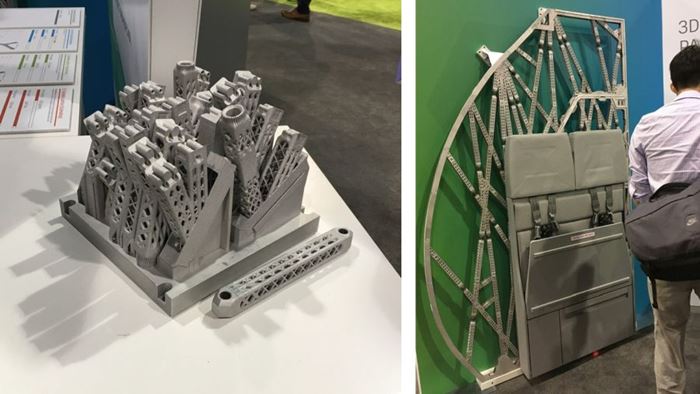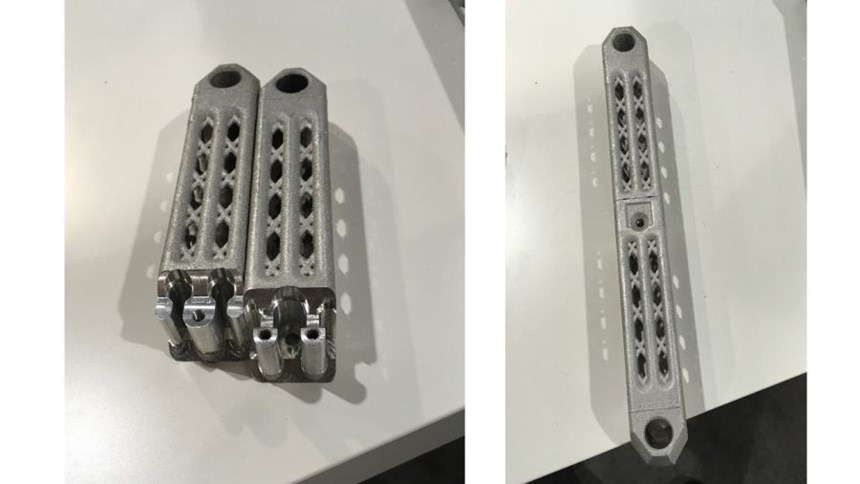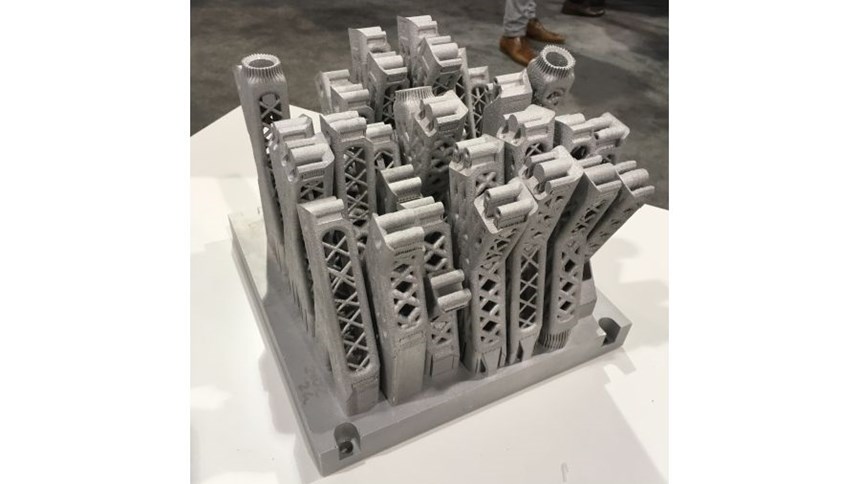Airbus Partition Built in Pieces for Weight Savings
The large component was successfully produced within a limited build envelope thanks to connection features designed into the pieces. Advances in powder-bed build size will permit greater efficiency in producing parts such as these.
Weight savings is one of the promises of additive manufacturing. A powder-bed process such as direct metal laser sintering (DMLS) makes it practical to generate a metal part that is neither solid nor hollow, but instead comprised of a mesh or lattice structure for the combination of light weight and high strength. In theory, the part could be engineered to have only the mass needed for the application and not a gram more. Still, the relatively small build size of powder-bed additive machines works against this important promise, because it is obviously big parts that offer the best opportunities for saving weight. The smaller parts able to be built within the envelopes of these machines often don’t offer much weight to save.
Aircraft maker Airbus recently demonstrated a workaround for this challenge with a large interior component it reengineered for weight savings. The frame of the partition within the A320 aircraft that separates the passenger compartment from the galley was reconceived for AM, with its solid aluminum alloy members replaced by lattice-like structures. The change reduced the weight of the partition by 45 percent. However, the nearly 7-foot-tall frame is vastly bigger than the envelopes of the EOS M290, EOS M400 and Concept Laser M2 machines used to additively produce it…so the big part was grown in pieces.
Airbus Innovation Manager Bastian Schäfer says the redesign of this partition frame is part of a company initiative to reduce greenhouse gas emissions on current aircraft. Lighter weight on an aircraft means less fuel for a given trip, reducing emissions. I spoke with him about this at a recent Autodesk event. (The partition was redesigned using Autodesk software.)
He says part of what made this design successful is the fact that the weight savings came without any component connected to this partition having to be changed. The new partition fits all of the same interfaces as the old one. Regulatory bodies must review changes to aircraft designs, he notes, so it sped approval significantly that only this part needed recertification and not a much larger assembly. The lightweight partition is now approved to fly, meaning airlines can replace the partitions on their A320s with this version. He guesses partitions like this might be in full production within two years, but the idea is still being refined. While the use of additive for this component is straightforward and ready for production, there are still some challenges in the secondary steps.
“The difficulty is the connections between the 3D-printed pieces,” he says. “After hot isostatic pressing, we measure each piece to find the connection surface, then CNC mill the feature to bring it to tolerance.” This step is performed one piece at a time today. Efficiency in full production will require this operation to be somehow systematized or automated.
A bigger powder-bed machine would help as well, he says. Just an incremental increase in build size over that of the machine used to make these pieces so far would have a meaningful impact on productivity. By permitting larger pieces, the larger size would reduce the number of connections that have to be machined. It would also allow more of the partition to be made in a single build. Right now, seven additive builds are needed to make all the pieces in one partition. Getting that number of builds smaller would deliver a processing time improvement. In short, the redesign of this partition almost certainly isn’t finished, says Schäfer. Airbus is investigating the use of a larger powder-bed machine with an eye toward these types of savings.
Related Content
This Drone Bird with 3D Printed Parts Mimics a Peregrine Falcon: The Cool Parts Show #66
The Drone Bird Company has developed aircraft that mimic birds of prey to scare off problem birds. The drones feature 3D printed fuselages made by Parts on Demand from ALM materials.
Read MoreWhy AM Leads to Internal Production for Collins Aerospace (Includes Video)
A new Charlotte-area center will provide additive manufacturing expertise and production capacity for Collins business units based across the country, allowing the company to guard proprietary design and process details that are often part of AM.
Read MoreAdditive Manufacturing Is Subtractive, Too: How CNC Machining Integrates With AM (Includes Video)
For Keselowski Advanced Manufacturing, succeeding with laser powder bed fusion as a production process means developing a machine shop that is responsive to, and moves at the pacing of, metal 3D printing.
Read More“Mantis” AM System for Spacecraft Uses Induction for Deposition
The metal 3D printing system melts wire without lasers. 30-foot-diameter parts are built on a rotary-feed system that eliminates the need for a large machine frame or gantry.
Read MoreRead Next
3D Printed Polymer EOAT Increases Safety of Cobots
Contract manufacturer Anubis 3D applies polymer 3D printing processes to manufacture cobot tooling that is lightweight, smooth and safer for human interaction.
Read MoreAlquist 3D Looks Toward a Carbon-Sequestering Future with 3D Printed Infrastructure
The Colorado startup aims to reduce the carbon footprint of new buildings, homes and city infrastructure with robotic 3D printing and a specialized geopolymer material.
Read MorePostprocessing Steps and Costs for Metal 3D Printing
When your metal part is done 3D printing, you just pull it out of the machine and start using it, right? Not exactly.
Read More























